“It is a mistake to think that moving fast is the same as actually going somewhere.”
― Steve Goodier
I’ve learned to hike faster to get to the summit, the lake, the waterfall, get to the canyon, or the climbing wall, or just to finish the loop. Sure, I’ll stop and enjoy the views along the way, but I don’t dawdle. I move much faster than the average hiker. That’s because I have too much to do to lollygag along the trail. I have a job, a family, Adventure School, community service, but I still make time to adventure regularly. How do I do it? I hike fast when I’m out. I plan carefully and I overlap when I can.
Fast hiking starts before you get to the trail
I prepare in advance so I can be efficient in transitions and get to my destination quickly. If it involves hiking before the climb or ski or canyon, I hike fast. Sometimes I hike for the sake of hiking and in those instances, I may not hike as fast, but preparation for all the stages of the day is key to being fast and efficient with the minimal time we all have.
Organize your pack
Before I even start packing my bag, I like to put all the supplies I’m bringing in a big pile and get it all organized. I pack my pack using good technique, but beyond that, I pack, it based on when throughout the day I plan on using each item. What will the conditions be like at the
Since the invention of the hydration bladder, water breaks are only for the ill-prepared. Having a water hose right where you need it throughout the day can save all kinds of time finding your water bottle and also helps you stay more hydrated.
Tie your shoes
Tie your shoes well so you don’t end up having to stop and re-tie them after the first mile. This also applies to your layering system. If you plan to remove or add layers of clothing throughout the day, have a plan for how you’ll do it so you don’t have to take your pack off and dig through it. I usually have a side pocket on my pack either empty and ready to stash my layers in or full of layers that I may want to add.
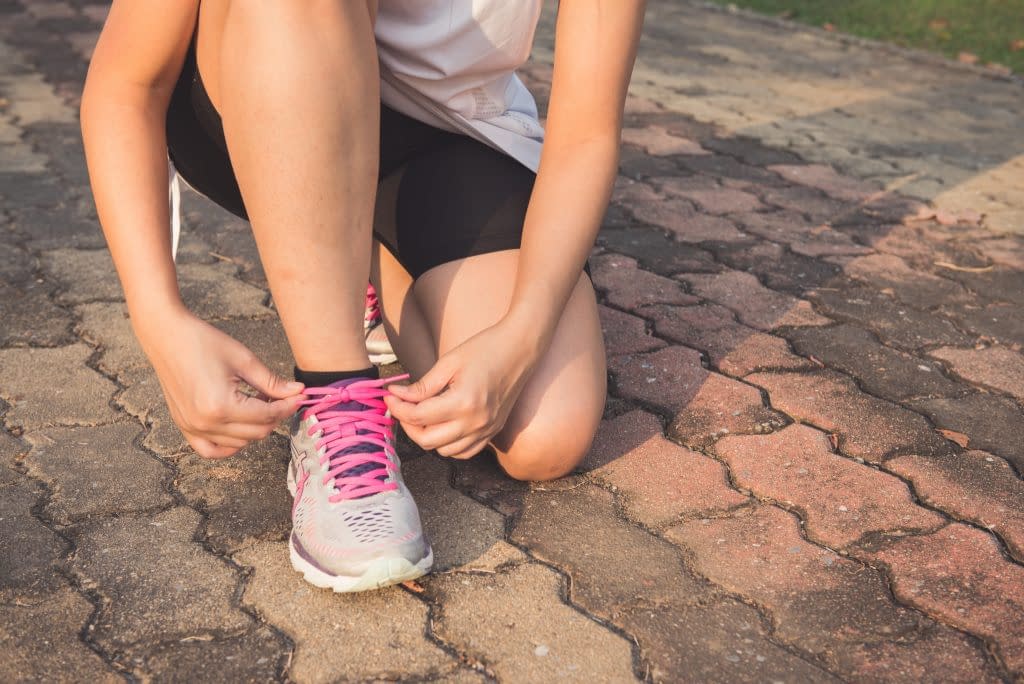
If you’re looking for a great pair of shoes for hiking or trail running, check out the Montrail Mountain Masochists. I’m loving mine
Bring easy food
I know some people may struggle to eat while they hike, but if you bring the right food and put it in the right container, it’s easy and makes for faster hiking to pull a protein bar out of your pocket and munch while you walk than it is to need to pull out the jars of peanut butter and jam and make a sandwich on the side of the trail. Store snacks in your hip belt or side pockets and eat small amounts throughout the day. This creates a more balanced energy intake and prevents you from hitting the wall and will keep you hiking fast. If you just can’t enjoy the hike without a PB & J, make one ahead of time and stash it in a quick access pocket.
Navigate quickly
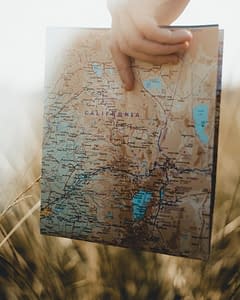
Another practice I can’t imagine not doing before a hike is having my navigation plan and tools prepared and ready for use. There’s no better way to spoil an adventure than getting off track and wasting time backtracking and being lost. To prevent this, study the route in advance and have your map, GPS, or other nav tools at hand throughout the hike. Check it frequently and avoid lengthy stops to orient yourself. By doing so, you will know exactly where you are and where you’re headed at all times. On many trails, this can even be done while you walk.
I use my
Learn more about navigation skills here, here, and here.
Feel the rhythm, feel the rhyme, get on up, it’s hiking time
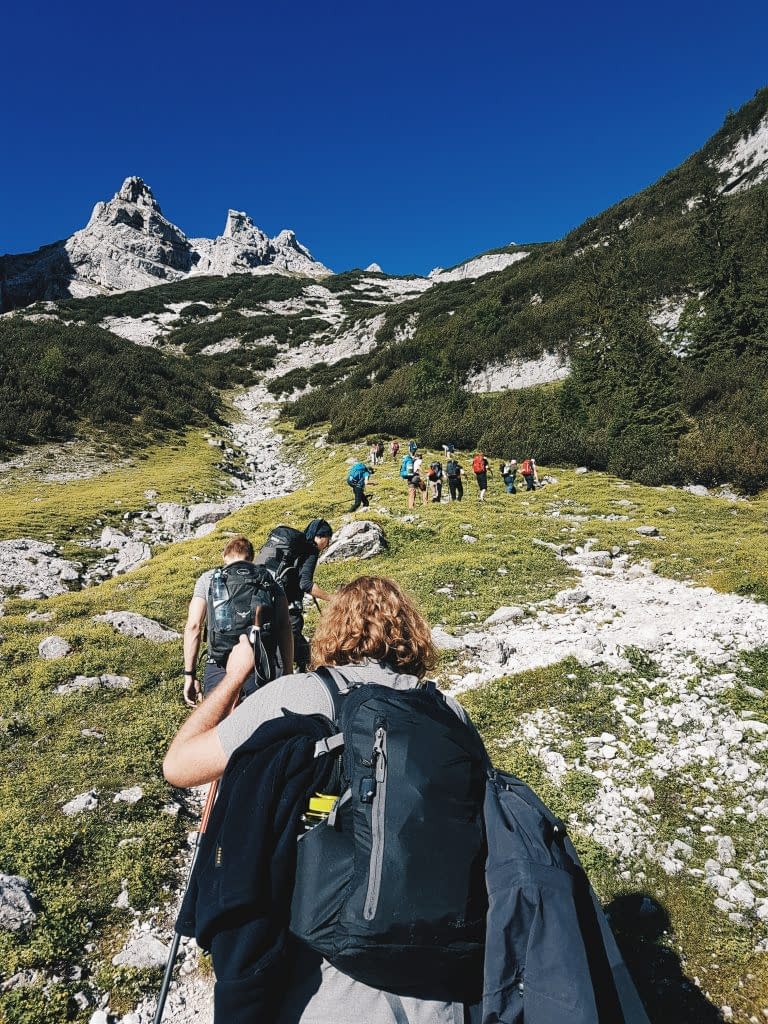
When I was a Boy Scout, I had a leader who was probably in his mid-fifties. I remember going on a 50 miler with him and being so impatient with him and the other slow leaders. I was fast back then and even faster now and I wanted to get on with it. My leader said, “the ox is slow, but the earth is patient.” I remember thinking, “yeah, but I’m not patient.” Fortunately, I’m a bit more patient now, but I did learn a valuable lesson from my leader. He was steady, he had flow, he wasn’t fast, but he kept a good tempo. A great way to hike fast is to set a tempo to your pace and keep it.
If you like to listen to music while you hike this can help. Many don’t like music when out adventuring (I’m likely to have a podcast playing). I also tend to have a naturally fast hiking tempo. You can make your tempo whatever you want it to be, you just have to adjust the distance of each step. Short, quick steps for a fast tempo and long, striding steps for a slower tempo – both can lead to fast hiking, but the most efficient is quick steps (more on that it a bit). A fun game is to use a watch that tracks cadence and try to keep the same cadence on the uphill, the downhill, and everything in between.
Think like a cat
Another trick is to move with the terrain. I like to try to move like a cat – smooth, quick, and silent. Firm foot placement, but quick steps with a low center of gravity leads to surefootedness while hiking fast.
Be water
If the cat imagery isn’t doing it for you, water is also a good way to think about it. Water always takes the path of least resistance and it moves with the terrain. If you think like water you’ll take efficient steps and be able to move quickly down the path of least resistance. Sometimes that’s not possible, or not safe, but do your best.
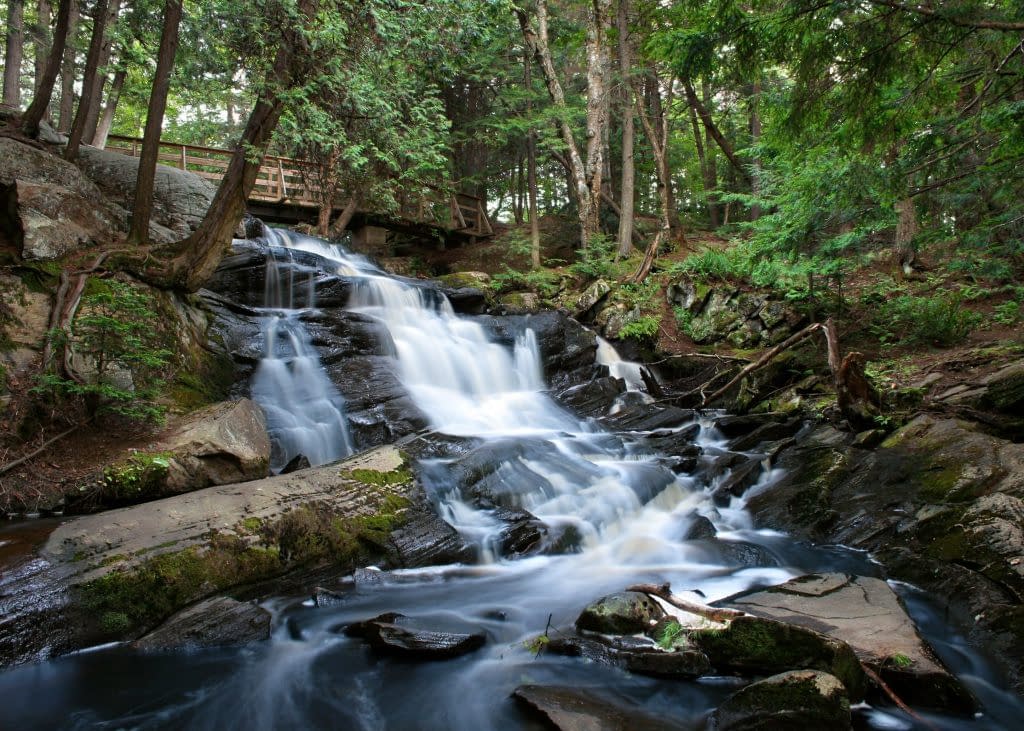
Get fit
On the uphill, the way to move faster is the long term game of getting stronger and more fit by trail running. Just regularly trail running will keep you hiking fast. I have a good trail with varied uphill, downhill, sandy, rocky, and wooded terrain that I run on
On the downhill, fitness makes a difference too, but it involves a bit of technique and finesse. When there’s a gentle slope down, you can run taking longer strides and use gravity to your advantage. As the trail gets steeper, shorten your strides until you’re taking quick little shuffle steps. Again, think like a cat and keep a low center of gravity and keep your weight right over your feet. This will add stability and allow you to move safely even at high speeds. When you get to the bottom of the hill, use your momentum to run out on the flats with big strides. This isn’t always doable if you have a heavy pack, but works most of the time. The most important part is to keep a quick pace. Keep your feet moving forward the whole time and keep your balance.

Be efficient in any terrain
It’s one thing to hike fast over a smooth and
Sand
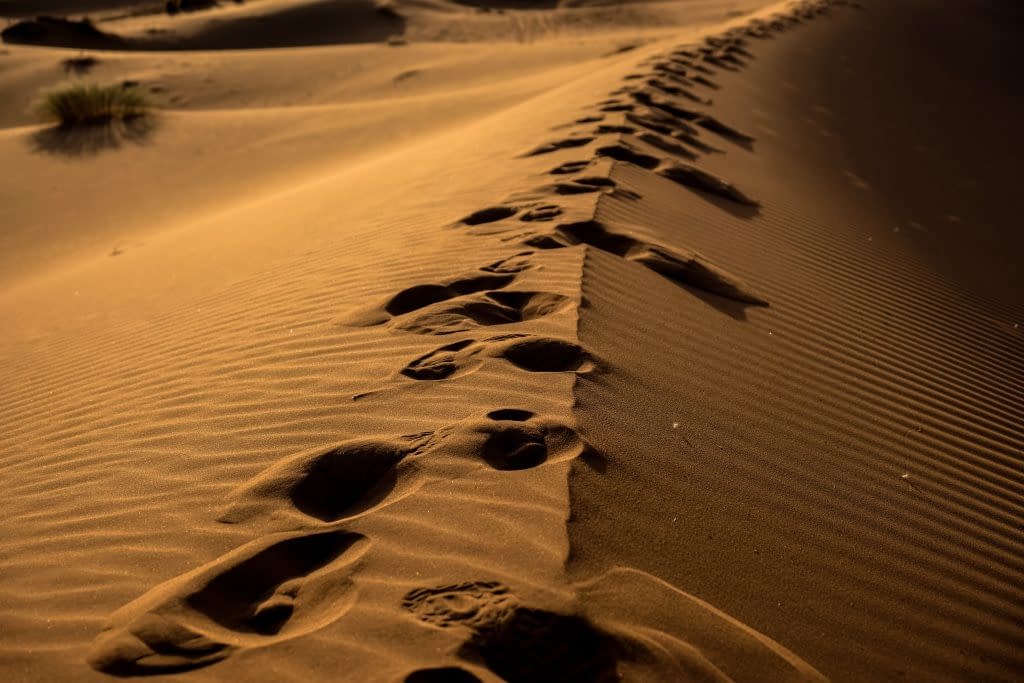
I’ve spent plenty of time trudging through sand here in the deserts of Utah. While sand is almost never easy, a good way to prepare for it is to wear the right shoes. A pair of Chacos typically doesn’t work well for me. I don’t like having the sand stuck between my toes and under my heel. I prefer a pair of light trail running shoes like
I also always try to stay on wet sand, rocky sand, or more packed sand where possible. It’s not always possible, but staying out of the loose sand is always more efficient. When you have to trudge through the soft sand, take a bit bigger strides and keep moving. I think like a running back. As long as my feet are still moving forward, I’m making progress.
Snow
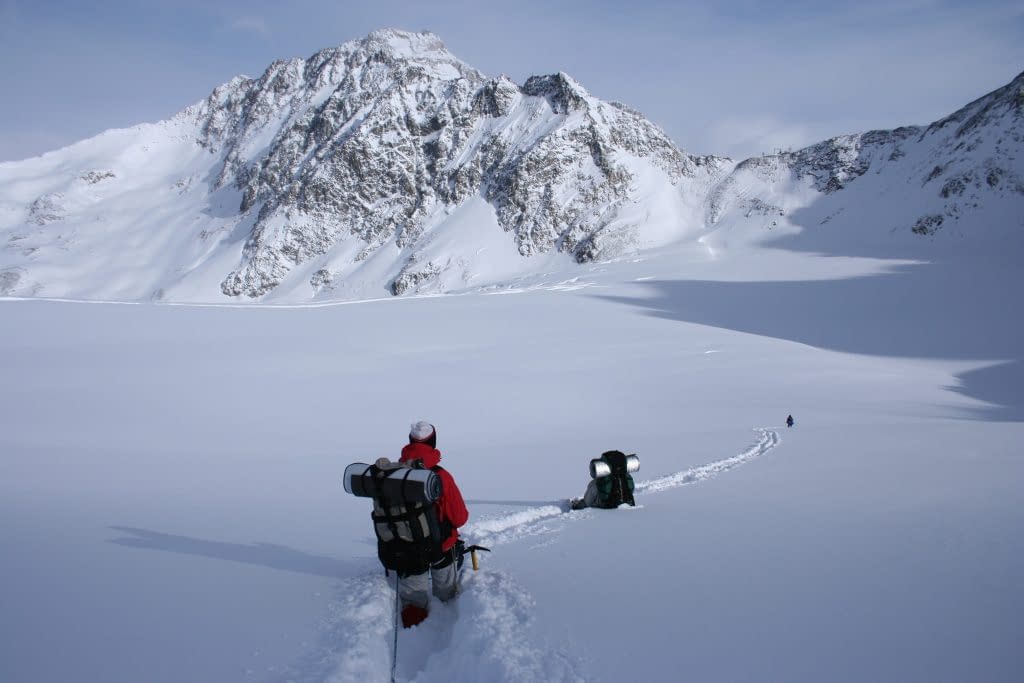
How you hike fast over snowbound terrain is dependent on the condition of the snow and the slope of the terrain. I won’t be able to go in-depth into snow travel, but in general, when the snow is soft and fresh, stay out of the deep stuff. Keep to the footprints already present or take large steps straight up and down. Wear gaiters and waterproof shoes or snowshoes if needed.
If the snow is deep with a crust on top, you may be in for some fun
Uphill on snow
When going uphill in snow, use a kickstep to kick your toes into the hillside rather than trying to smear your whole sole out on the slope. It may not seem like it would work, but trust me, a bit of toe buried in the snow is much more stable than trying to grip with your whole foot.
Downhill on snow
On the downhill, the same applies, but with your heel. Use your heel to plunge step into the snow to get a solid placement. If the snow is soft as is often the case during spring and early summer hiking in the mountains on a sunny afternoon, you can often make up a ton of time by using glissade steps. This is sliding down the hill on your feet. This takes practice, balance, and can be very hard for beginners to figure out, but if you can learn how to glissade down the snowfields, you can make great time on the downhill. There’s one peak near my house that has a glacier year-round that I like to glissade down on my butt. It turns an hour-long descent off the saddle into a 5-minute adrenaline slide.
Ice
If the snow is icy, nanospikes or crampons are usually in order, especially when going up or down slopes.
Having some extra traction on slippery or icy surfaces can not only help you hikeRead this article to learn more about winter trail running
Scree
Hiking up or down scree slopes can be brutal. There’s not a great way to be efficient or fast in scree. If it’s small enough, you can do a bit of glissading coming down, but usually, the rocks are big enough that this just ends in rocks smashing into your ankle bones. You also have to be careful that nobody is below you because aggressive movements through scree fields can cause falling rocks. On the way up, just try to keep moving and mind your foot placement so you don’t step on sliding rocks. Sometimes that means finding bigger, more stable rocks, but that’s not always possible. If you can, go around the scree. If there’s no other way but through, just know you’re not alone in being slow over scree.
Boulders
Sometimes boulders can be the fastest way through, but often they’re a dangerous place to spend much time. Boulder hopping can quickly end in a sprained ankle, but if you have practiced your cat skills, the best way to move over boulders is with quick hops from one boulder to the next. Occasionally you may find yourself on all fours trying to scramble through, but hopping through with stable footings can be fun and a good change of pace to the plodding along we do on the trail. I usually find myself thinking “be a cat” or “be a mountain goat” when I’m in boulders and it works well for me.
Cross country
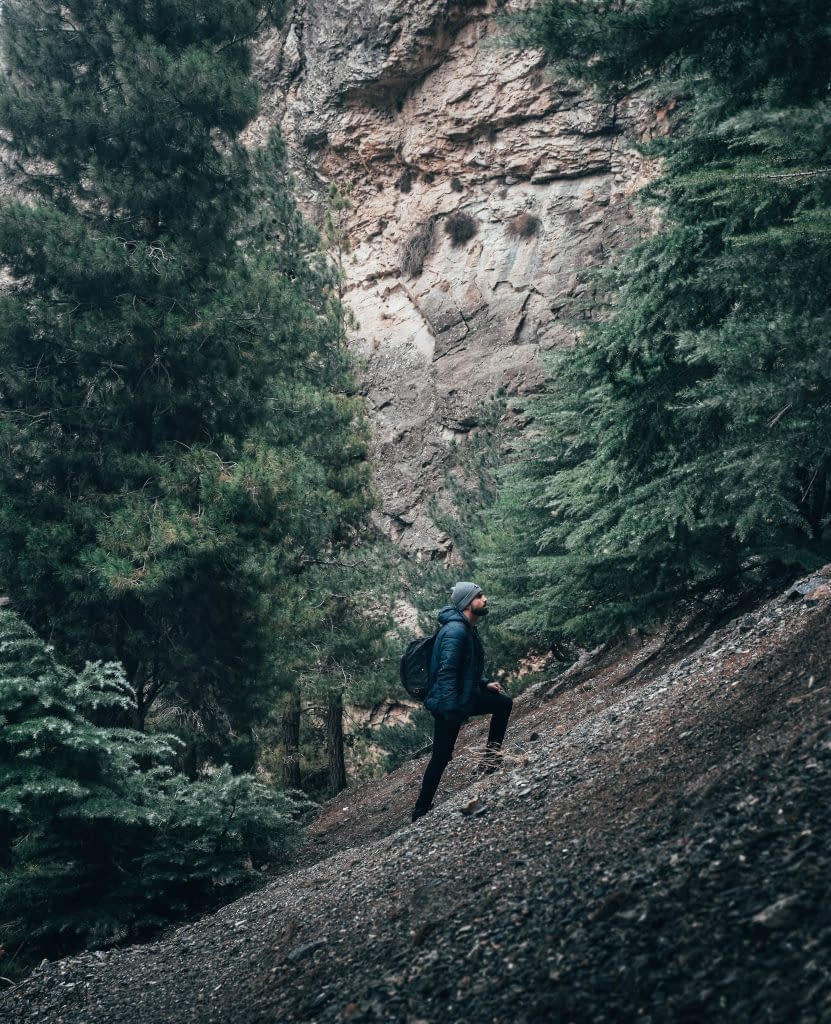
When the trail disappears and you find yourself in open terrain, the best way to keep hiking fast is to keep your head up and find a point in the distance that you can focus on to work toward. This helps you avoid meandering through the brush in an inefficient line. You want to move straight toward your target. Looking up will help, but you’ll also have to be good at picking out good lines as you work toward your target. The straight line may lead you to a cliff band or through a thicket. Looking ahead will alow you to see those sorts of obstacles and navigate around them so you can keep hiking fast.
When the terrain gets steep, take your time and always pay attention to your navigation target. The fastest way to slow yourself way down is to go off course.
Fast breaks
Fast hiking requires fast breaks. In fact, I rarely take breaks other than a quick photo op, bio break, or to fix something that will slow me down over the long run like putting moleskin on a hot spot. If I do take a break, it’s fast. I don’t take my pack off and linger. This helps keep my muscles warm and not stiffen up. If I have to stop because someone else needs a break, I usually stay on my feet and stretch out my muscles. This helps my partners get back up sooner, but also helps me limber up stiff muscles that have been getting the same range of use for hours on end. This is also where all my trail running comes in handy. While some people will be winded and gassing after just a mile or so, I’m still fresh.
Mental prep
As a summary, I think the most important thing you can do to hike fast and use your trail time more efficiently is to prepare for what you’ll need on the trail, build up your fitness level your trail confidence over mixed terrain, and to consciously hike faster. If you put it in your mind that you want to move fast over any type of terrain and on the uphills and the downhills, you’ll find yourself moving faster automatically. Turn it into a game and see if you can only pass people on the trail and never be passed or see if you can set a time you’ll reach a certain destination. If you are conscious about how quickly you’re moving, you’ll move faster.
Hiking fast isn’t always the right thing to do, but hiking fast can be a great skill to have if you want to pack more adventure into less time. I hope this guide was helpful and that you can get out there and get more adventures in as you spend less time in transit on the trail.



